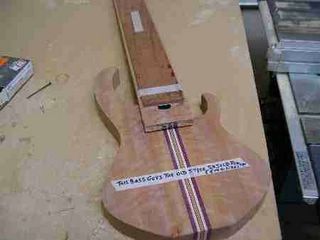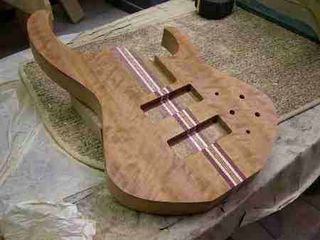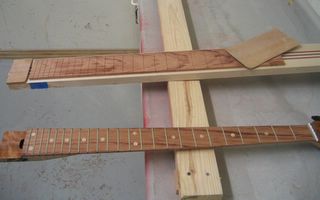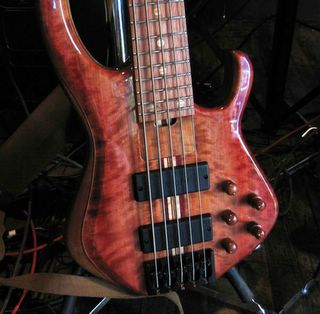My Skjold Custom 5
So, with all that background, I find myself in the Dallas/Ft. Worth area on business, and I decided to stop in and see this maker, Pete Skjold, whom I had read so much about here on TalkBass. If nothing else, I had to see if the headstock on his basses was really as huge as everyone seemed to think!
But, the real magic began when I had the chance to play his basses. The first thing I noticed was that they just felt really good in my hands, and that it was comfortable for me to play anywhere on the fingerboard. His 5 string basses felt really natural to me, and I think a lot of 4-string guys would also be quite happy with them. The next thing I noticed was the quality of the construction and the georgeous finishes. I nearly had to break out a bib to control the drooling!
So, after playing all of these basses (through four different Schroeder cabs!), I began talking more with Pete about what I was looking for in a bass, and what options I might consider, if I were to get a Skjold bass. I figured I would get back to him in a couple of months, if I did decide to go with one of his basses. Mahogany was a given for the body wood, and after playing a bunch of his basses, I decided that bubinga was my preferred fingerboard material. So, he's showing me some big chunks of mahogany, then we look at necks (I really liked his 5-7 piece necks), then he shows me a knockout slab of bubinga, and it hits me... These chunks of wood we are looing at will become my bass! It really did just hit me. I mean, here I am loving the way Pete's basses play, loving the way they sound, and then really seeing these pieces of wood coming together into an instrument, and it finally just clicked. I asked Pete if he could fit one more bass into his current batch, and he said that there was just enough time to sneak one more in. The clincher was when we were looking through top woods to match up with the mahogany and I saw this lonely old piece of rose myrtle over in the corner. It was all over at that point. I had to have this bass!
So, Pete spends a bunch more of his time with me going over what I want (options, etc.), and we come up with some of the ideas like using the same wood as the fingerboard (bubinga) for the knobs, to provide some contrast (which I think turned out great). He told me that he is switching to a more narrow pickup cover, but I prefer to anchor my thumb on a wider pickup cover, so we stick with the old covers on mine, and so on...
A few weeks later, I get to see my first photos of my bass in progress:

and

Even though they are small photos, of a bass very early in its development, I am understandably quite excited at this point!
Next, I get a few more enticing "progress shots."

and

At this point, I am even more fired up, because I am totally stoked at how good the bass looks, especially that fingerboard. Unfortunately, some bad news was due to come my way...
Pete calls me up and lets me know that there is a problem with the necks on this batch of basses. The issue is related to the compound radiusing that they were using, and for reasons that I don't fully understand, this batch of necks had a slight "stair stepping" of the frets, which required them to adjust the neck angle slightly to keep the frets from buzzing. As I understand it, the differences here were extremely minor, and probably not visible to the naked eye, but Pete and Ron knew they were there. They did work out a solution, but it required raising the action very slightly. Chances are, it would have been fine, but it was not perfect in their mind, so they redid all of the necks on the basses in that batch. Unfortunately, they did not have another matching piece of bubinga for my fingerboard, though they did have more from the same piece of wood. Here is a photo posted by my good bud, Juneau, showing the old neck next to the new fingerboard:

I was so in love with that first fingerboard, that initially, I was kind of bummed with the new board, but it started to grow on me. Especially after Juneau posted some more shots of its progress:
And while he was at it (and the neck was off), he got some more shots of the body:
And I really started to dig the new fingerboard when I first saw pictures of it on the body (thanks again, Dave!):
The shots from Juneau continue:
This shot shows the nice flame maple dots:
Okay, so I finally get the bass in my hands last Wednesday, and the real payoff begins! [Note: some of this information is paraphrasing what I have posted in other threads.] I had a little bit of time to play it here at the office before heading home for lunch, and I was immediately very impressed. Visually, my first thoughts were that the photos do not do it justice. The subtle flaming in the rose myrtle top is very 3D and moves depending on the angle you look from. It also really varies with the lighting. The finish is very deep, and nicely done. I'm not sure if you can tell or not, but it has a red burst around the edges.
After playing it for just a bit, I intially thought that I would have to tweak the setup slightly for Ohio's climate, but after it had a chance to "recover" from the shipping process, the action is now pretty darn close to what I would call perfect (and I didn't have to do a thing!).
I asked Pete to make the neck as thin as possible, and boy did he deliver! I liked the fairly thin neck on my DeArmond Pilot 5 Deluxe, and this neck is even more thin, but still feels very sturdy, and really fits well in my hand. The neck is not as wide as the one on my Pilot, and this is taking a little getting used to, but it definitely enhances playability, and I am liking the slightly closer string spacing.
As to how it sounds, the first thing I noticed was that it speaks very well unplugged. You could probably learn/write a song on this thing unplugged, you can hear yourself that well. Very balanced and rich sounding. The fresh strings (nickel plated steel, roundwound) help, I am sure, but that aside, it still sounds great and is very loud unplugged. Once I plugged it in, I was surprised at how much high end this instrument has. Again, new strings make a difference, but even accounting for that, it's still brighter than I expected. Being made from mahogany, I expected a full, yet tight, low-mid presence, and good overall tonal balance, and it certainly has both. But the high end clarity still caught me somewhat by surprise (pleasantly, so). During most of my initial playing, I left the passive tone bleed set about halfway, and this seemed perfect. [Note: the highs seemed to have tamed down just a tad from the first day that I played it, though they are still very clear and speak very well - but I now just crank back a little on the "vintage tone control."]
The overall tonal character hit me as complex, airy, woody, and articulate. The low B was very, very tight and clear. Tonally, it is very well balanced, and I like the passive tone very well. I did notice, though, that the volume takes a pretty noticeable jump when you kick it into active mode, though, so I'll have to keep that in mind at gigs. I asked Pete about this, and he said that it's just a matter of the gain being up slightly on the preamp. This is adjustable, but he felt that it might be nice to have a slightly hotter signal for some amps, and of course you can back off a bit on the volume if this is too much.
The pickup selector knob (neck only, both in series, both in parallel, and bridge only) yields a huge range of tones just by itself, and the "Made to Skjoldspecs by John East" preamp offers a crazy variety of tonal options. The cool thing is, that the way Pete has selected his pickup windings and the way that he has tweaked the East preamp specs, you almost can't find a bad tone from this instrument! The pickups are very transparent, and Pete was trying to capture the best of the Jazz Bass pickup sound, but took great care to avoid having the pickups add anything (frequency-wise). The preamp is also designed to be very transparent, and the active tone is quite similar to the passive tone (with volume compensated), though the tone does get somewhat more full and tight in active mode (perhaps from a slight impedance change, or from removing the draw of the instrument cable on the pickups?).
It's early in the relationship (perhaps I should call it a "love affair!"
As a result of this clarity, I am finding that this bass just loves tube amps. The setup that I first played my Skjold through was my DB 359 into a Whappo, Jr. The Jr. is a great cab to use with tube amps, and this combo was tonal nirvana! At our gig last Saturday, I played it through a combined SS/Tube rig, with my Aguilar 680/728 powering the Whappo, Jr., and a Crest CA9 driving a Tri 210L on top of a Gordo. I also use a Pignose B-100V for a "rhythm guitar" rig (through an Akai UniBass).

Here are some more shots of the Skjold from that gig:


The low end on this bass is so tight, that the slight blurriness that I usually hear in the lows when using a tube amp (especially at higher volumes) was practically non-existent. Even the low B was tight, quick, and dynamically explosive through the 680/728. This rig sounds great with any bass, but with the Skjold, the clarity and tightness is truly amazing.
As stated, the love affair is very new, and I am sure that I will be on cloud 9 for some time. If I do encounter anything negative, I will be sure to report on it, though don't be surprised if you don't hear anything from me on this topic!
I also need to mention that Pete has called me and e-mailed me several times after I received my bass to be sure that I am happy. Great customer service!
A few notes that I forgot to add. One reason that I think that Pete's basses have such great high end and detail (with his electronics, at least) is that he uses a "pickup combination selector knob" instead of individual volume pots or a blend pot. This means that there is one (in the case of Vol/Vol) or two (in the case of Vol/Blend) less pots loading down the pickups and potentially (excuse the pun) bleeding out some of the high end. The pickup selector allows you to choose from neck only, both in series, both in parallel, or bridge only. Yes, you do lose the ability to dial in every possible blend variation, but the range of tones from these four choices is huge (and I love the series/parallel option). And the fact that you have less pots between the pickups and the output (in passive mode) or preamp (in active mode) seems to provide increased clarity and high end performance.
Another neat feature (especially in Pete's price range) is the locking input jack. I have to remember it's there, but I saw those a while back and I thought it was a great innovation.
One option that Pete offers which I thought was neat is the ability to have your straplock receptacles flush mounted, so there is no strap knob sticking out from the bass. A standard Strap Lock will snap right in. This option looks cool (if someone unusual), but I opted against it. I'd hate to show up for a gig and have a strap lock fail on me (or forget to bring the strap with the locks!). But, it is an interesting option, for those with better memories (and backup Strap Locks!).
One final note, and that is that I really like the lightweight Gator case that it came with. It has the proportions and inner lining of a hardshell case, but the outside is a cordura-like canvas, and it zips closed (instead of having a couple of latches). It is very light, but seems quite sturdy. I may pick one up for one of my other basses.
[Time passes...]
Well, I keep waiting for the honeymoon to be over before I get back here and post some follow ups, but I'll be darned if I ain't still head over heels in love!
In short, this bass is all that I had hoped, and a whole lot more.
But, for some more specific comments, I have to re-emphasis the clarity of this instrument. It is just phenomenal! And the kicker is that it is both clear and full sounding, which seems to be quite a feat, after playing many high end basses that were either one or the other. For the record, my new Sadowsky 25th is also full and clear sounding, but moreso than the Skjold on the "full" thing and less so than the Skjold on the "clear" thing.
The other highlight of this instrument has been its playability. I am primarily a fingerstyle player, and I find it to be very comfortable for this approach. The pickup covers make a great thumbrest (and are more comfortable than many). I asked Pete and Ron to make the neck as narrow as possible, and I really like what they delivered. Don't even think about the word "chunky" in the same room as this bass!
Now that I do have my Sadowsky 25th Anniversary 24 Fret 5 string, it is inevitable to make comparisons between the Sadowsky and the Skjold. The added benefit of this is more practice time for me (which is sorely needed!).
Before receiving these basses, I had expected that the Skjold would be my "workhorse" and the Sadowsky would be kept in the vault.
Here are some shots of the two "hanging out" together:
And if you ask me, I think it speaks very highly of Pete and Ron's work that my Skjold Custom 5 compares so well to a truly world-class instrument from Roger Sadowsky!
One thing that I forgot to point out. In the photos of my Skjold and Sadowsky, I tried to hang the basses such that the top of the necks were at approximately equal levels. This shows you how the body of the Skjold trims off very quickly after the bridge. This makes for a more compact body, and to a certain extent, it makes the headstock look big in certain photos. But, if you compare it to the Sadowsky's headstock, you can see that it is actually fairly compact.
One other thing about the "truncated" end of the Skjold is that with the way it balances (quite well, BTW), the neck is moved somewhat to the right, closer to your body, a very small amount. This has the effect of making 1st position an easier, more comfortable reach. It's quite easy to get used to, and I think on the whole, it enhances the playability.
Now, what kind of Skjold bass to get next?
The comment: I am blessed to own a number of very excellent basses, and among all of them, my primary gigging axe is my Skjold Custom 5.
The photos (yes, with pyschadelic carpet background!): This is my first string change since I picked up this bass (shocking, I know!), and I like the black hardware, so I thought I would accentuate it a bit:
Tom.

2 Comments:
For some reason, some of the photos show up and others don't. Please bear with me, and I will try to fix this.
Thanks, Tom.
All photos should now work! Please tell me if any of them do not.
Post a Comment
<< Home